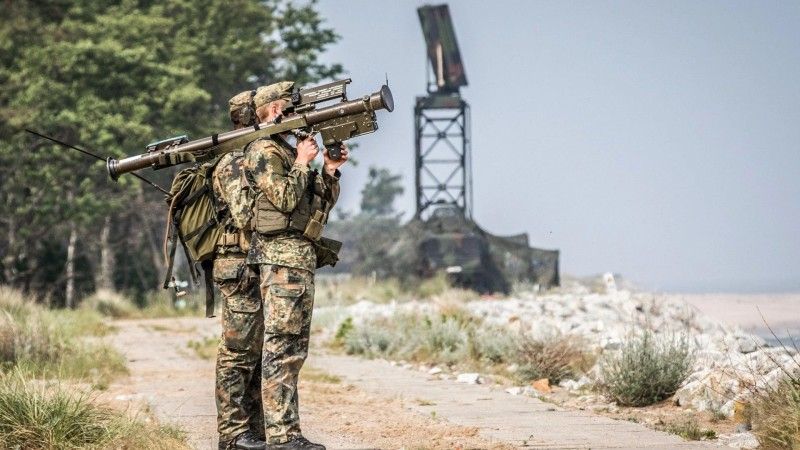Germany Procures Expensive Stinger Missiles. A Lost Opportunity for Polish Piorun MANPADS?

Germany has signed a contract through the NATO agency NSPA for the supply of around half a thousand Stinger portable anti-aircraft systems. Despite the higher price, it was not decided to purchase the Polish Piorun systems, which have been combat proven in Ukraine. For the time being, however, there is no decision on funding for further modernisation of the Piorun, while other MANPADS systems manufacturers are improving their solutions.
During the NATO summit in Washington, a contract was signed for the purchase of 940 Stinger man-portable anti-aircraft missiles, at a cost of nearly $700 million, or around 2.7 billion zlotys. More than half of these, 506, are to go to the German armed forces. The Bundestag recently agreed to spend €395 million, or just over $420 million, for this purpose. The delivery date is quite distant, as it is expected to take place between 2028 and 2029.
However, Germany will receive one of the latest versions of the Stinger missiles, the FIM-92K Block 1, equipped with a proximity fuze. The same missiles will also go to other countries that have purchased these anti-aircraft kits, namely Italy and the Netherlands. We should add that the agreement was signed through the NATO agency NSPA, using the industrial cooperation mechanisms in place since 1990 to support European users of Stinger missiles. The new missiles, unsurprisingly, will largely be a replacement for those delivered to Ukraine after a full-scale invasion by European allies.
We should add that the Americans have been slow to increase production of these missiles, as they had to be reconstituted virtually from scratch after the outbreak of a full-scale war. There have been reports that by 2025 Stinger production is expected to be 60 missiles per month (an increase from 40 per month).
By comparison, France has decided to increase production of the slightly heavier (fired from a tripod, or vehicle, not from the shoulder) Mistral missiles, from 20 to 40 per month. Poland, on the other hand, will produce more than 1,000 Piorun missiles per year (or more than 80 per month) from this year onwards. Thus, it can be seen that Poland, by maintaining its competence and continuously developing it, is a leader in NATO when it comes to man-portable anti-aircraft systems (MANPADS).
Piorun have very high performance, as the course of the war in Ukraine confirms. They allow effective combat against a variety of target types, from fixed wing aircraft and helicopters to cruise missiles and small drones. They are capable of operating in difficult conditions and fighting targets at distances from 400m to more than 6.5km and at altitudes from 10m to more than 4km.
The Piorun have also become one of the Polish industry’s export hits, as - in addition to earlier deliveries to the US and Ukraine, also carried out commercially - they have recently been ordered by Estonia, Norway (they have been deployed near the Russian border), Latvia (to replace the Stingers given to Ukraine) and one unnamed Balkan country, and talks are also underway on an intergovernmental agreement for their supply with Slovakia.
Polish kits are, of course, also supplied to the Polish Armed Forces in large numbers, because alongside the first contract in 2016 for 420 launch mechanisms and 1,300 missiles, another contract was concluded in 2022 for 3.5 billion gross for 3,500 missiles and 600 launch mechanisms.From comparing the prices of the two contracts, it is clear that the unit price of the Piorun missile is significantly lower than the Stinger, even when inflation is taken into account.
This contract will be fulfilled by 2026. The question, however, iswhat happens next. It must be remembered that after combat use, the Russians and the Iranian or Chinese engineers who support them will try to find countermeasures, especially as, with so much fighting, complete sets have almost certainly fallen into their hands.The Piorun therefore needs modernising. Some steps have already been taken with the industry’s own money and using previous NCRD (NCBR) development contracts. However, the modernisation of the Piorun should be supported by the state, under another similar multi-year procurement, allowing work to be completed and missiles to be delivered in a newer configuration. Assuming that the Piorun is to remain a portable set, with the possibility of use on systems such as the Poprad, Kusza or Pilica, as this is the military’s expectation, the modernisation should cover the guidance system and a slight increase in range, andwork in these two directions is already underway. However, further large-scale procurements along the lines of those in 2022 and taking into account technology developments are needed to implement them and put them into large-scale production. If, on the other hand, there are no orders, there is a risk of both the loss of operational advantage (which - in an ongoing war involving an opponent with a mobilised economy - is never given »once and for all«), but also the loss of the export potential that Piorun has today. And the concrete benefits for the Polish economy associated with it.
It is worth quoting some figures here. The Americans have already commissioned a development project for a successor to the Stinger. The two participating companies: Raytheon and Lockheed Martin have received a total of more than $700 million (or around 2.8 billion PLN), of which Raytheon received 418 million and Lockheed Martin 312 million. Such a large amount of funding provides the opportunity to prepare a new generation of MANPADS by 2028, and to move it into large-scale production. It can be expected that the development project will run at least to some extent in parallel with the building of production capacity, and that this capacity will be larger than today or in 2025 for the Stingers.
Despite all the problems of the supply chains and the different shape they took during the Cold War, it can be assumed that within a few years Western production of equipment, including the MANPADS, will finally be increased. As recently as the early 1990s, the French were reaching a production capacity of up to 250 Mistral missiles per month, a figure that until recently was produced annually. Perhaps the Americans will achieve a similar production volume if it is assumed that the Stinger’s successor can be introduced in numbers of at least 10,000. In other words, thelack of further investment in the production and development of the Piorun may mean that in less than a decade Poland will lose its dominant position in the MANPADS market.
We should add that the Piorun kit has a very wide range of development possibilities also in terms of how it can be used. Some work is already underway to develop a version to be carried by helicopters. Another solution, already presented in the past, is to place the Piorun launcher on an Unmanned Land Vehicle, such as the PIAP-Lukasiewicz robot. Such a solution could be an effective support to protect and defend critical infrastructure, but also troops on the front line. Under such a solution, a module with two Piorun missiles, an optoelectronic system and an optional IFF module is placed on a boom mounted on the robot and can remain in ambush for an extended period of time, keeping the battery of the anti-aircraft kit powered in a similar way to the Kusza system. This allows it to reduce the response time to a threat and fight even targets that manoeuvre to minimise exposure time to the anti-aircraft kit. And such a kit can be built in principle from existing components, solely by the forces of domestic industry. It is also still possible to develop, on the basis of the Piorun, a missile with a range of more than 10 km, complementing the air defence system and acting as a reinforcement for the Poprad and future Sona systems. Such a missile, with a guidance system at an early stage, would be particularly advantageous from a cost-effectiveness point of view, featuring greater capabilities than the man-portable sets and at a much lower cost than the missiles procured in the Narew and Pilica programmes.
Today, Poland is the leading producer of man-portable anti-aircraft sets in NATO, surpassing even the best developed countries both in terms of the effectiveness of its solutions and the cost-effectiveness ratio. Maintaining these advantages, however, requires the continuation of multi-year procurements and investment in the development of the capabilities held. Without these elements, the Polish advantage may be lost, which will have a negative impact both on the capabilities of the Polish Armed Forces and on the condition and export opportunities of the armaments industry. #PHOTO[ id: 1662865 | desc: Redady to use Piorun launcher . Bachmut front, 2002 ]



